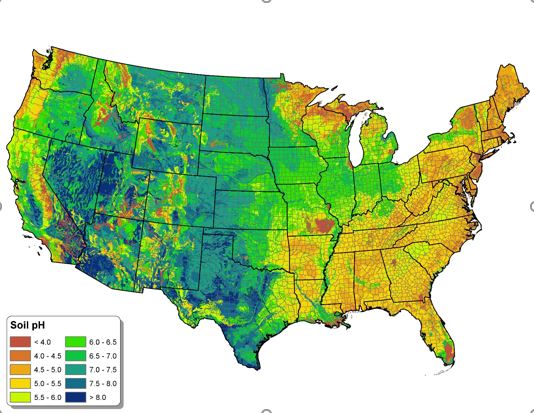Lime Amounts for Soil Application
Fertilizer becomes less effective in acidic soils. If the soil pH is 5.5 or lower, up
to one-third of the fertilizer can be wasted. Moreover, the use of fertilizer can contribute to
increasing soil acidity. After several years of applying fertilizer without adding lime amendments, the
soil pH may drop below 6.0.
Maintaining proper soil pH allows fertilizers to work effectively, resulting in lush green lawns and
high-yield gardens.
Steps to Determine Lime Application for Your Lawn
- Refer to the soil test recommendations to determine the amount of lime required per 1,000 square feet.
- Check the CCE (calcium carbonate equivalent) percentage of your lime product, which is typically indicated on the back of the bag.
- Divide the soil test recommendation by the CCE percentage, then multiply the result by 100 to calculate the amount of liming material required per 1,000 square feet.
Measuring Liming Area - Square Footage (sf)
There are 43,560 square feet in one acre. To determine the square footage of an area, measure its length and width and multiply these two values. If you need to combine multiple areas, calculate the square footage of each one separately and then add them together for the total. For any areas that need to be removed, calculate the square footage of those sections and subtract that from the total.
Limestone Requirements to Raise Soil pH
To increase the pH level by 1.0 for every 1,000 square feet, the required limestone varies based on soil type:
- Sand: 25 pounds
- Loam: 75 pounds
- Clay: 100 pounds
Suggested Rates of Pellet Lime Application for Lawns
- 1/8-acre, 5,000 sq. ft.: 5 bags
- 1/4-acre, 10,000 sq. ft.: 10 bags
- 1/2-acre, 15,000 sq. ft.: 20 bags
- 1-acre, 40,000 sq. ft.: 40 bags
These recommendations are based on maintaining a neutral soil pH. If your soil pH is not neutral, you may need to double the recommended quantity.
Spreader Setting Recommendations
- To apply 10 lbs. per 1,000 sq. ft., set spreader to 33% (one-third) of its fully open setting.
- To apply 20 lbs. per 1,000 sq. ft., set spreader to 66% (two-thirds) of its fully open setting.
- To apply 40 lbs. per 1,000 sq. ft., set spreader to 90% (7/8) of its fully open setting.
- To apply 80 lbs. per 1,000 sq. ft., set spreader to 90% (7/8) of its fully open setting and make two perpendicular passes (crisscross).
Lime Application for Different Lawns
- New Lawns: Apply 40 pounds per 1,000 sq. ft. Rake lightly into the soil before seeding.
- Established Lawns: Apply 12 lbs. per 1,000 sq. ft.; for clay soil, increase to 18 lbs. per 1,000 sq. ft.
- Maintenance: Repeat this process 1-2 times per year or when the soil pH drops below 6.3, using 4-6 lbs. of lime per 1,000 square feet.
- Corrective pH Applications: As a general guideline, applying 50 to 100 pounds of lime per 1,000 square feet is a common practice.

